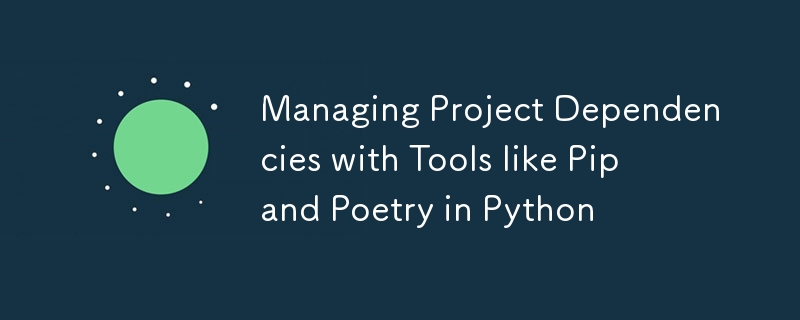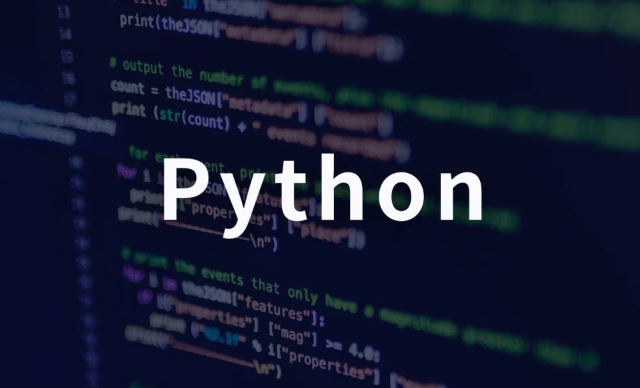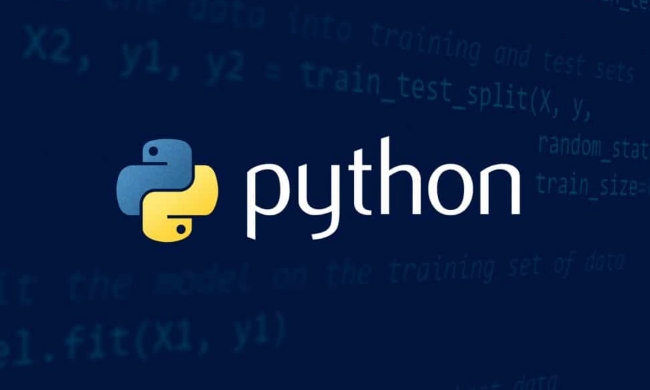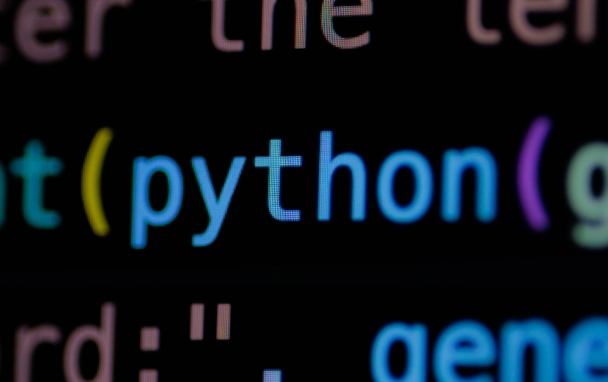 Backend Development
Backend Development
 Python Tutorial
Python Tutorial
 Managing Project Dependencies with Tools like Pip and Poetry in Python
Managing Project Dependencies with Tools like Pip and Poetry in Python
Key tools for Python project dependency management are Pip and Poetry. 1. Pip is suitable for small projects with requirements.txt. It installs dependencies through pip install -r requirements.txt, but it is difficult to separate the production and production environment. 2. Poetry is a more modern tool that automatically creates virtual environments, uses pyproject.toml and poetry.lock to accurately lock dependency versions, supports development of dependency markups (such as poetry add --dev pytest), and can build publishing packages. 3. Choose based on project complexity: Use Pip for simple scripts, and recommend Poetry for professional projects to improve stability and reproducibility.

Python project dependency management is a key part of the development process, especially when teams collaborate or deployed to different environments. Using tools like Pip and Poetry can help you more clearly control the various library versions required by the project, avoiding problems such as environmental chaos and version conflicts.

What is project dependency?
Simply put, dependencies are the third-party libraries necessary for your project to run. For example, if you write a web application and use Flask, then Flask is one of your dependencies. Sometimes these dependencies also have their own dependencies (called sub-dependencies), and it is easy to make mistakes when managed manually. At this time, tools are needed to help.

Pip requirements.txt: The most basic approach
If you are just starting to get involved in Python project management, you may have used pip install -r requirements.txt .
- All packages and versions that need to be installed are listed in the
requirements.txtfile, such as:flask==2.3.0 requests>=2.28.1
Advantages : Simple and direct, suitable for small projects or quick testing.

Disadvantages : It cannot handle the separation of development dependencies and production dependencies well, and does not support functions such as automatic creation of virtual environments.
Tips: Use
pip freeze > requirements.txtto export all dependencies of the current environment, but be aware that this method will write all installed packages into it, which may contain content you do not want.
Poetry: A more modern way of dependency management
Poetry is a dependency management and packaging tool designed specifically for Python. It not only helps you manage dependencies, but also helps you build and publish your own packages.
Installation and initialization
You can install Poetry through the officially recommended method:
curl -sSL https://install.python-poetry.org | python3 -
Then run in the project root directory:
poetry init
This will guide you to create a pyproject.toml file that records the basic information and dependencies of the project.
Adding dependencies is simple
Want to add a dependency? Run directly:
poetry add flask
Poetry will automatically download the latest version and update pyproject.toml and a lock file called poetry.lock . The latter ensures that you install the exact same version combination on different machines.
Separate the dependency
Some packages are only used in the development stage, such as pytest and black. Poetry allows you to specifically tag them as "dev" dependencies:
poetry add --dev pytest
This allows you to choose not to install these dependencies when deploying a production environment:
poetry install --no-dev
How to choose Pip or Poetry?
This problem actually depends on the size and complexity of your project:
- If you just write a small script or use it for teaching, Pip plus requirements.txt is enough.
- If you want to better manage dependency trees, lock versions, or even prepare for package releases, then use Poetry.
In addition, Poetry also supports generation of traditional distribution formats such as setup.py and wheel, and it is easier to integrate CI/CD processes.
In general, whether it is Pip or Poetry, the key is to establish a clear dependency management process. Don't wait until it is launched to find that a certain version has changed and causes the program to report an error. Using these tools well can make your project more stable and reproducible.
Basically that's it.
The above is the detailed content of Managing Project Dependencies with Tools like Pip and Poetry in Python. For more information, please follow other related articles on the PHP Chinese website!

Hot AI Tools

Undress AI Tool
Undress images for free

Undresser.AI Undress
AI-powered app for creating realistic nude photos

AI Clothes Remover
Online AI tool for removing clothes from photos.

Clothoff.io
AI clothes remover

Video Face Swap
Swap faces in any video effortlessly with our completely free AI face swap tool!

Hot Article

Hot Tools

Notepad++7.3.1
Easy-to-use and free code editor

SublimeText3 Chinese version
Chinese version, very easy to use

Zend Studio 13.0.1
Powerful PHP integrated development environment

Dreamweaver CS6
Visual web development tools

SublimeText3 Mac version
God-level code editing software (SublimeText3)
 Polymorphism in python classes
Jul 05, 2025 am 02:58 AM
Polymorphism in python classes
Jul 05, 2025 am 02:58 AM
Polymorphism is a core concept in Python object-oriented programming, referring to "one interface, multiple implementations", allowing for unified processing of different types of objects. 1. Polymorphism is implemented through method rewriting. Subclasses can redefine parent class methods. For example, the spoke() method of Animal class has different implementations in Dog and Cat subclasses. 2. The practical uses of polymorphism include simplifying the code structure and enhancing scalability, such as calling the draw() method uniformly in the graphical drawing program, or handling the common behavior of different characters in game development. 3. Python implementation polymorphism needs to satisfy: the parent class defines a method, and the child class overrides the method, but does not require inheritance of the same parent class. As long as the object implements the same method, this is called the "duck type". 4. Things to note include the maintenance
 Explain Python generators and iterators.
Jul 05, 2025 am 02:55 AM
Explain Python generators and iterators.
Jul 05, 2025 am 02:55 AM
Iterators are objects that implement __iter__() and __next__() methods. The generator is a simplified version of iterators, which automatically implement these methods through the yield keyword. 1. The iterator returns an element every time he calls next() and throws a StopIteration exception when there are no more elements. 2. The generator uses function definition to generate data on demand, saving memory and supporting infinite sequences. 3. Use iterators when processing existing sets, use a generator when dynamically generating big data or lazy evaluation, such as loading line by line when reading large files. Note: Iterable objects such as lists are not iterators. They need to be recreated after the iterator reaches its end, and the generator can only traverse it once.
 How to handle API authentication in Python
Jul 13, 2025 am 02:22 AM
How to handle API authentication in Python
Jul 13, 2025 am 02:22 AM
The key to dealing with API authentication is to understand and use the authentication method correctly. 1. APIKey is the simplest authentication method, usually placed in the request header or URL parameters; 2. BasicAuth uses username and password for Base64 encoding transmission, which is suitable for internal systems; 3. OAuth2 needs to obtain the token first through client_id and client_secret, and then bring the BearerToken in the request header; 4. In order to deal with the token expiration, the token management class can be encapsulated and automatically refreshed the token; in short, selecting the appropriate method according to the document and safely storing the key information is the key.
 How to iterate over two lists at once Python
Jul 09, 2025 am 01:13 AM
How to iterate over two lists at once Python
Jul 09, 2025 am 01:13 AM
A common method to traverse two lists simultaneously in Python is to use the zip() function, which will pair multiple lists in order and be the shortest; if the list length is inconsistent, you can use itertools.zip_longest() to be the longest and fill in the missing values; combined with enumerate(), you can get the index at the same time. 1.zip() is concise and practical, suitable for paired data iteration; 2.zip_longest() can fill in the default value when dealing with inconsistent lengths; 3.enumerate(zip()) can obtain indexes during traversal, meeting the needs of a variety of complex scenarios.
 What are python iterators?
Jul 08, 2025 am 02:56 AM
What are python iterators?
Jul 08, 2025 am 02:56 AM
InPython,iteratorsareobjectsthatallowloopingthroughcollectionsbyimplementing__iter__()and__next__().1)Iteratorsworkviatheiteratorprotocol,using__iter__()toreturntheiteratorand__next__()toretrievethenextitemuntilStopIterationisraised.2)Aniterable(like
 Explain Python assertions.
Jul 07, 2025 am 12:14 AM
Explain Python assertions.
Jul 07, 2025 am 12:14 AM
Assert is an assertion tool used in Python for debugging, and throws an AssertionError when the condition is not met. Its syntax is assert condition plus optional error information, which is suitable for internal logic verification such as parameter checking, status confirmation, etc., but cannot be used for security or user input checking, and should be used in conjunction with clear prompt information. It is only available for auxiliary debugging in the development stage rather than substituting exception handling.
 What are Python type hints?
Jul 07, 2025 am 02:55 AM
What are Python type hints?
Jul 07, 2025 am 02:55 AM
TypehintsinPythonsolvetheproblemofambiguityandpotentialbugsindynamicallytypedcodebyallowingdeveloperstospecifyexpectedtypes.Theyenhancereadability,enableearlybugdetection,andimprovetoolingsupport.Typehintsareaddedusingacolon(:)forvariablesandparamete
 Python FastAPI tutorial
Jul 12, 2025 am 02:42 AM
Python FastAPI tutorial
Jul 12, 2025 am 02:42 AM
To create modern and efficient APIs using Python, FastAPI is recommended; it is based on standard Python type prompts and can automatically generate documents, with excellent performance. After installing FastAPI and ASGI server uvicorn, you can write interface code. By defining routes, writing processing functions, and returning data, APIs can be quickly built. FastAPI supports a variety of HTTP methods and provides automatically generated SwaggerUI and ReDoc documentation systems. URL parameters can be captured through path definition, while query parameters can be implemented by setting default values ??for function parameters. The rational use of Pydantic models can help improve development efficiency and accuracy.





